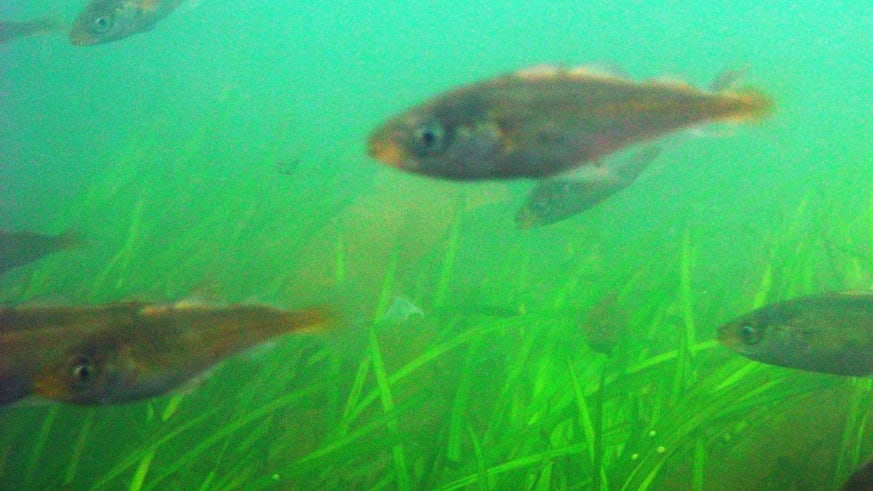For the love of cod, let's save our disappearing seagrass
27 November 2014

Seagrass is one of the most important coastal habitats where young ocean-going fish such as Atlantic cod can grow and develop before setting out on the journey of life. But these critically important habitats, revealed in new research, are being damaged the world over and its not just threatening biodiversity but our food security.
Some 30,000 km2 of seagrass (Zostera marina) has disappeared over the past two decades, about 18% of the global area. This is incredibly important. One hectare of seagrass absorbs 1.2 kilogrammes of nutrients each year, equivalent to the treated effluent of 200 people. It can produce 100,000 litres of oxygen per day, can support 80,000 fish and 100m invertebrates – and absorb ten times as much CO2 as a pristine area of Amazon rainforest.
Key marine resource
Providing shallow-water habitats where young ocean-going fish can grow and develop is one of the key ecosystem services that our coastal seas provide, but unfortunately we largely don't recognise the value of them in supporting the fishery resources of vast ocean basins. We continue to allow the loss of this coastal habitat to occur throughout the world – in spite of regulations in many nations to protect key habitats and biodiversity
The diminished status of fisheries for species such as the Atlantic cod (Gadus morhua) means we need to move beyond purely managing adult fish stocks and consider the interaction of individual high-value species within the whole seascape and the critical habitats within that.
This is critical as our declining fishery stocks do not align with the needs of the region or the planet as a whole. To meet the needs of the predicted human population of 2050, an additional 75m tons of protein from fish and aquatic invertebrates will be required – this is a 50% increase in current supply.
The Atlantic cod is a species of significant economic and historic importance but is now better known for its catastrophic decline. Apart from overfishing, the causes of this decline and its subsequent lack of recovery remain largely unresolved. The degree to which specific coastal and shallow-water habitats are important for this species still remains unquantified at the scale of the North Atlantic.
There is extensive evidence of the presence of juvenile Atlantic cod in seagrass throughout the North Atlantic. Juvenile cod have been recorded in such high density in seagrass that they average 246 individuals per hectare.
This density of juvenile Atlantic cod is higher in seagrass meadows compared to alternative habitats. This includes an incredible dataset from Norway where researchers have sampled juvenile cod in seagrass annually since 1919 and other recent studies observing juvenile cod in seagrass in North Wales by our team at Swansea University using stereo Baited Remote Underwater Video systems and seine nets.
Juvenile Atlantic cod have greater long-term viability after having spent time in seagrass, which improves their chances of reaching maturity. The new analysis published in the open access journal, Global Ecology and Conservation, illustrates how juvenile Atlantic cod grow faster in seagrass than in surrounding alternative habitat types and have higher survival rates from predation. Although juvenile Atlantic cod do not always need to use seagrass meadows as juvenile habitats, it appears that they may intentionally select seagrass as a nursery habitat. This data comes from studies throughout the Atlantic including Newfoundland in the west and Sweden in the east.
Biodiversity and food security
The study, conducted by researchers at Swansea and Cardiff University was an extensive meta-analysis of research on the life history of the Atlantic cod resulting in a review and synthesis of its nursery habitat usage. It includes data sources from throughout the region, ranging from Newfoundland, to Norway, to Scotland and to Sweden.
The work provides strong evidence that seagrass meadows are of significant importance to contributing to Atlantic cod stocks, and our review presents extensive quantitative evidence of the role of seagrass as valuable nursery habitat for Atlantic cod. These findings are of major significance given the continued threats to these systems.
Seagrass meadows are globally important resources that are being threatened by a whole series of issues ranging from climate change and major weather events to boating activity, poor water quality and coastal development. This work clearly illustrates how key habitats in our coastal seas such as seagrass need protecting, not just for biodiversity but for the continued food security provided by our oceans.
Read the paper in full here